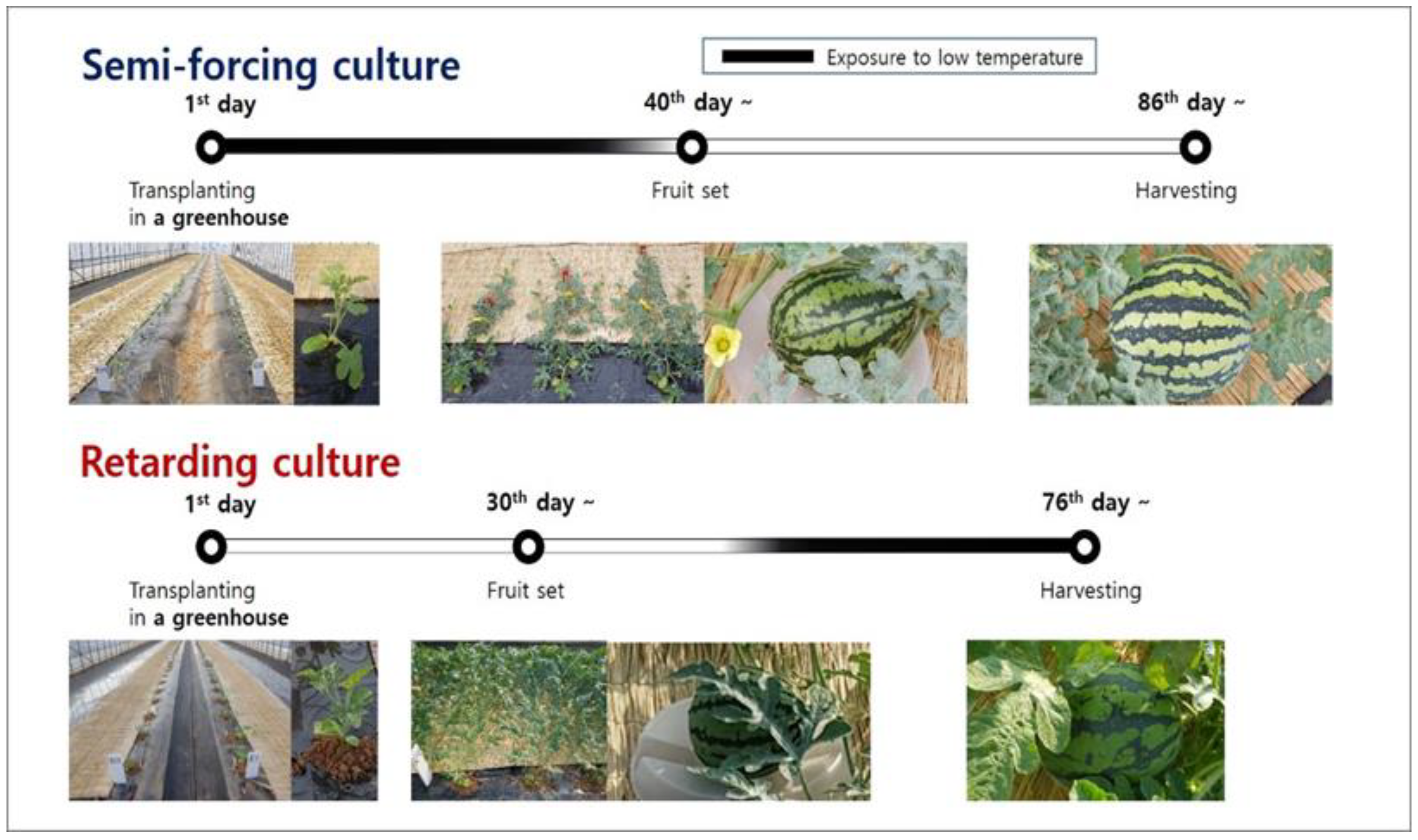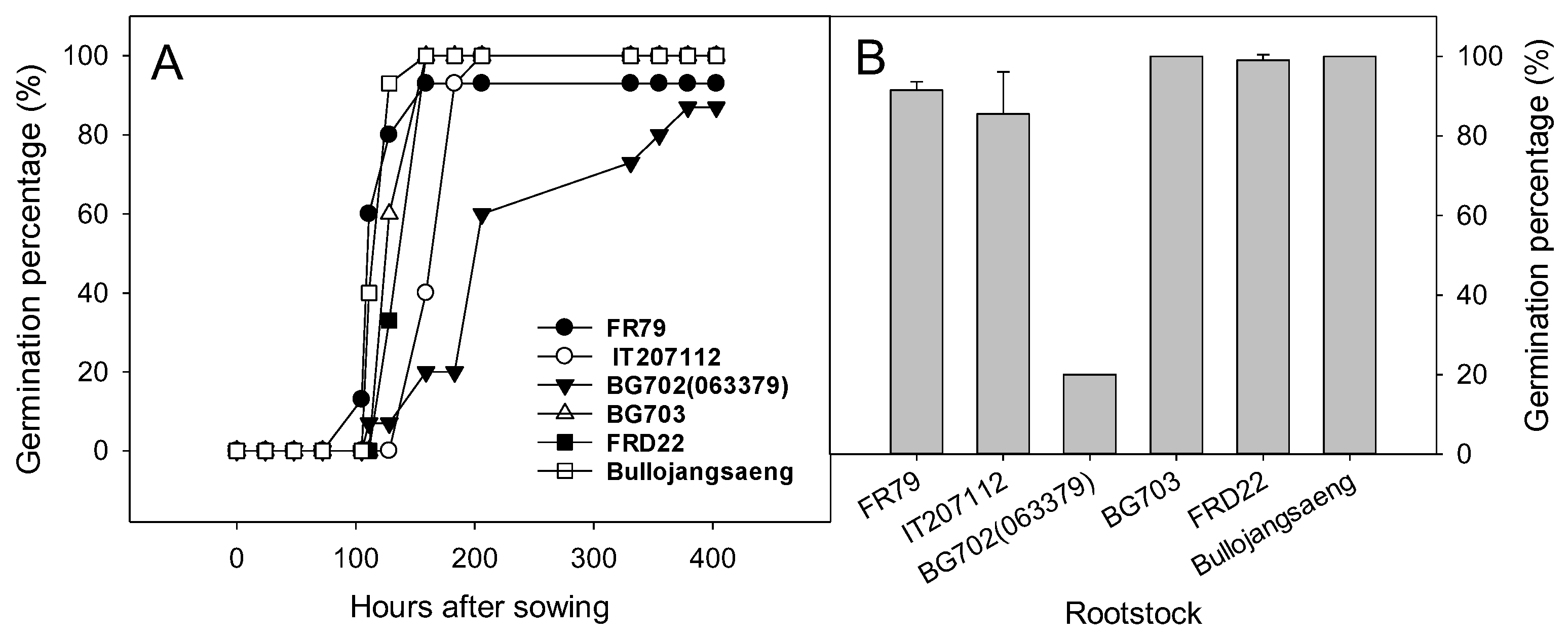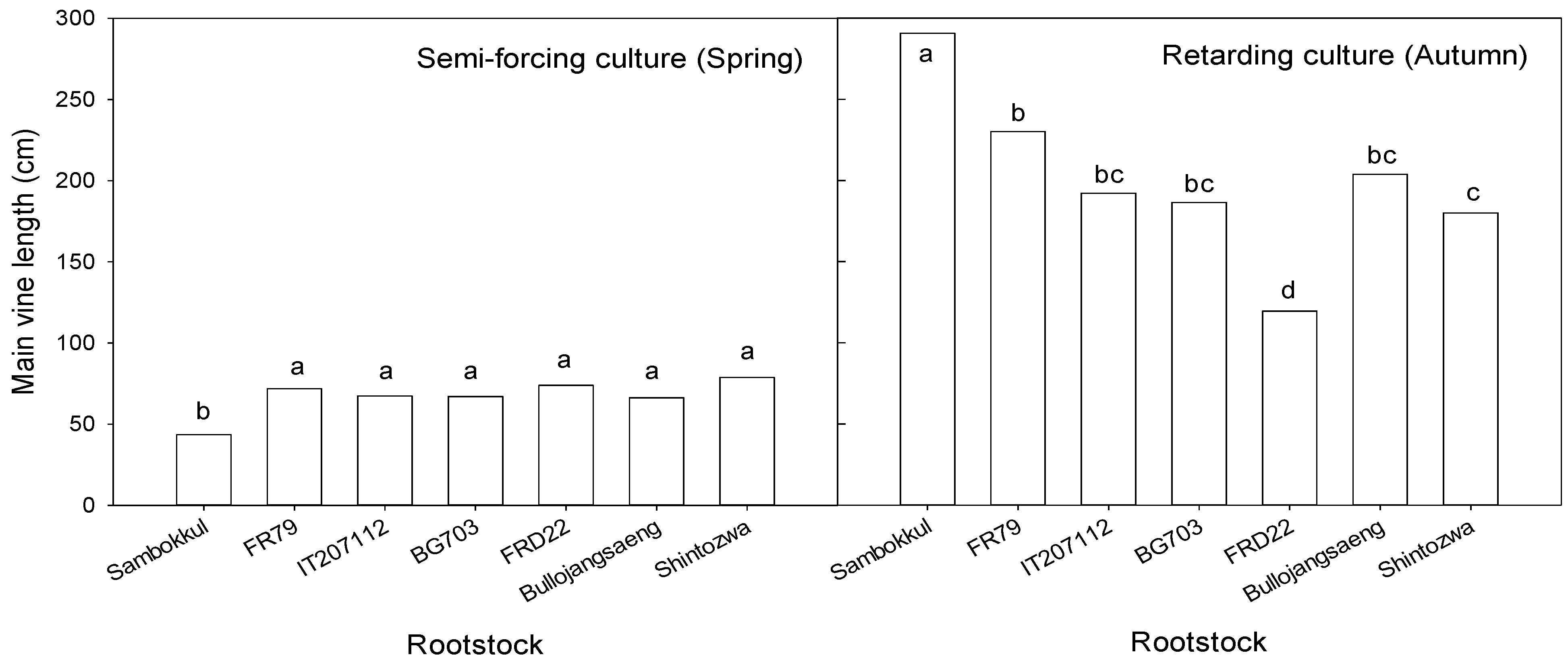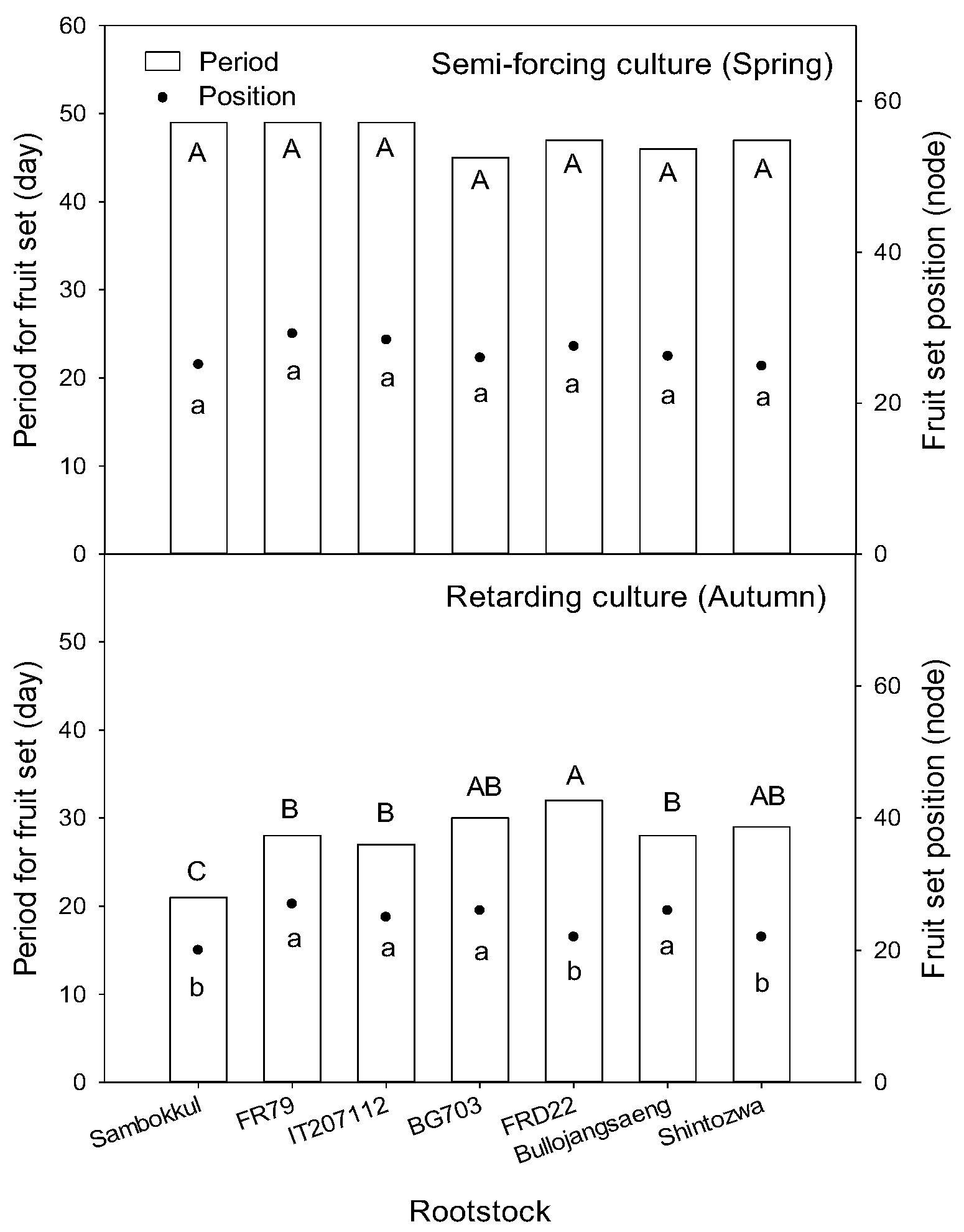Effect of Low-Temperature Tolerant Rootstocks on the Growth and Fruit Quality of Watermelon in Semi-Forcing and Retarding Culture
Abstract
:1. Introduction
2. Materials and Methods
2.1. Plant Materials
2.2. Cultivation of Grafted Watermelons in a Greenhouse
2.3. Measurements and Sensory Evaluation
2.4. Statistical Analysis
3. Results
3.1. Environment in Semi-Forcing and Retarding Culture
3.2. The Growth of Bottle Gourd Rootstock Accessions and Grafted Watermelon Transplants
3.3. The Growth of Watermelons in the Greenhouse
4. Discussion
5. Conclusions
Author Contributions
Funding
Data Availability Statement
Conflicts of Interest
References
- Rural Development Administration (RDA). Watermelon Cultivation; The Textbook for Farming No. 104; RDA: Jeonju, Republic of Korea, 2021. [Google Scholar]
- Lu, K.; Sun, J.; Li, Q.; Li, X.; Jin, S. Effect of cold stress on growth, physiological characteristics, and Calvin-cycle-related gene expression of grafted watermelon seedlings of different gourd rootstocks. Horticulturae 2021, 7, 391. [Google Scholar] [CrossRef]
- Noh, J.; Kim, J.M.; Sheikh, S.; Lee, S.G.; Lim, J.H.; Seong, M.H.; Jung, G.T. Effect of heat treatment around the fruit set region on growth and yield of watermelon [Citrullus lanatus (Thunb.) Matsum. and Nakai]. Physiol. Mol. Biol. Plants 2013, 19, 509–514. [Google Scholar] [CrossRef] [PubMed] [Green Version]
- Korkmaz, A.; Dufault, R.J. Short-term cyclic cold temperature stress on watermelon yield. Hort. Sci. 2002, 37, 487–489. [Google Scholar] [CrossRef] [Green Version]
- Lee, J.M.; Kubota, C.; Tsao, S.J.; Bie, Z.; Echevarria, P.H.; Morra, L.; Oda, M. Current status of vegetable grafting: Diffusion, grafting techniques, automation. Sci. Hort. 2010, 127, 93–105. [Google Scholar] [CrossRef]
- Jang, Y.; Mun, B.; Do, K.; Um, Y.; Chun, C. Effects of photosynthetic photon flux and carbon dioxide concentration on the photosynthesis and growth of grafted pepper transplants during healing and acclimatization. Hort. Environ. Biotechnol. 2014, 55, 387–396. [Google Scholar] [CrossRef]
- Pérez-Grajales, M.; Pérez-Reyes, T.Q.; Cruz-Álvarez, O.; Castro-Brindis, R.; Martínez-Damián, M.T. Compatibility of the rootstock CM-334 and its response on the yield, physicochemical quality and content of capsaicinoids in Capsicum pubescens. ITEA-Inf. Técnica Económica Agrar. 2021, 117, 332–346. [Google Scholar]
- Suárez-Hernández, Á.M.; Grimaldo-Juárez, O.; García-López, A.M.; González-Mendoza, D.; Huitrón-Ramírez, M.V. Influence of rootstock on postharvest watermelon quality. Rev. Chapingo. Ser. Hortic. 2017, 23, 49–58. [Google Scholar] [CrossRef]
- Devi, P.; Perkins-Veazie, P.; Miles, C. Impact of grafting on watermelon fruit maturity and quality. Horticulturae 2020, 6, 97. [Google Scholar] [CrossRef]
- Colla, G.; Rouphael, Y.; Cardarelli, M.; Rea, E. Effect of salinity on yield, fruit quality, leaf gas exchange, and mineral composition of grafted watermelon plants. Hort. Sci. 2006, 41, 622–627. [Google Scholar] [CrossRef] [Green Version]
- Colla, G.; Rouphael, Y.; Cardarelli, M.; Rea, E. The effectiveness of grafting to improve alkalinity tolerance in watermelon. Environ. Exp. Bot. 2010, 68, 283–291. [Google Scholar] [CrossRef]
- Yan, Y.; Wang, S.; Wei, M.; Gong, B.; Shi, Q. Effect of different rootstocks on the salt stress tolerance in watermelon seedlings. Hortic. Plant J. 2018, 4, 239–249. [Google Scholar] [CrossRef]
- Yetisir, H.; Sari, N. Effect of different rootstock on plant growth, yield and quality of watermelon. Aust. J. Exp. Agri. 2003, 43, 1269–1274. [Google Scholar] [CrossRef]
- Jang, Y. Current Status of Grafted Fruit Vegetable Transplants Production and Cultivation; National Institute of Horticultural and Herbal Science: Suwon, Republic of Korea, 2013; pp. 86–102. [Google Scholar]
- An, S.; Bae, J.H.; Kim, H.C.; Kwack, Y. Production of grafted vegetable seedlings in the Republic of Korea: Achievements, challenges and perspectives. Hort. Sci. Tech. 2021, 39, 547–559. [Google Scholar]
- Davis, A.R.; Perkins-Veazie, P.; Sakata, Y.; López-Galarza, S.; Maroto, J.V.; Lee, S.G.; Huh, Y.C.; Sun, Z.; Miguel, A.; King, S.R.; et al. Cucurbit grafting. Crit. Rev. Plant Sci. 2008, 27, 50–74. [Google Scholar] [CrossRef]
- Mkhize, P.; Mashilo, J.; Shimelis, H. Progress on genetic improvement and analysis of bottle gourd [Lagenaria siceraria (Molina) Standl.] for agronomic traits, nutrient compositions, and stress tolerance: A review. Front. Sustain. Food Syst. 2021, 5, 683635. [Google Scholar] [CrossRef]
- Wanog, Y.; Wang, L.; Xing, N.; Wu, X.; Wu, X.; Wang, B.; Lu, Z.; Xu, P.; Tao, Y.; Li, G.; et al. A universal pipeline for mobile mRNA detection and insights into heterografting advantages under chilling stress. Hortic. Res. 2020, 7, 13. [Google Scholar] [CrossRef] [Green Version]
- Kim, T.B.; Kim, E.J.; Nam, S.C. Standardized Production and Rootstock Development of Small and Medium-Sized Cucurbitaceae vegetables for Export; Research reports for 2021 (PJ012608); Rural Development Administration: Jeonju, Republic of Korea, 2022. [Google Scholar]
- Moon, J.H.; An, Y.G.; An, S.W. Breeding and Utilization of Rootstock Varieties to Reduce the Injury by Continuous Cropping in Cucurbitaceae vegetables; Research reports for 2017 (PJ008638); Rural Development Administration: Jeonju, Republic of Korea, 2018. [Google Scholar]
- McMaster, G.S.; Wilhelm, W.W. Growing degree-days: One equation, two interpretations. Agri. Forest Meteor. 1997, 87, 291–300. [Google Scholar] [CrossRef] [Green Version]
- Begna, S.H.; Angadi, S.V. Effects of planting date on winter canola growth and yield in the Southwestern U.S. Am. J. Plant Sci. 2016, 7, 201–217. [Google Scholar] [CrossRef] [Green Version]
- Xiong, M.; Liu, C.; Guo, L.; Wang, J.; Wu, X.; Li, L.; Bie, Z.; Huang, Y. Compatibility evaluation and anatomical observation of melon grafted onto eight Cucurbitaceae. Front. Plant Sci. 2021, 12, 762889. [Google Scholar] [CrossRef]
- Lee, D.U.; Bae, J.H.; Lim, J.H.; Choi, J.H. Prediction of consumer acceptance of oriental melon based on physicochemical and sensory characteristics. Hort. Sci. Tech. 2017, 35, 446–455. [Google Scholar]
- Ntatsi, G.; Savvas, D.; Papasotiropoulos, V.; Katsileros, A.; Zrenner, R.M.; Hincha, D.K.; Zuther, E.; Schwarz, D. Rootstock sub-optimal temperature tolerance determines transcriptomic responses after long-term root cooling in rootstocks and scions of grafted tomato plants. Front. Plant Sci. 2017, 8, 911. [Google Scholar] [CrossRef] [PubMed] [Green Version]
- Li, M.; Duan, X.; Liu, T.; Qi, H. Short-term suboptimal low temperature has short- and long-term effects on melon seedlings. Sci. Hort. 2022, 297, 110967. [Google Scholar] [CrossRef]
- Schwarz, D.; Rouphael, Y.; Colla, G.; Venema, J.H. Grafting as a tool to improve tolerance of vegetables to abiotic stresses: Thermal stress, water stress and organic pollutants. Sci. Hort. 2010, 127, 162–171. [Google Scholar] [CrossRef]
- Nabiwire, S.; Wakholi, C.; Faqeerzada, M.A.; Arief, M.A.A.; Kim, M.S.; Cho, B. Estimation of cold stress, plant age, and number of leaves in watermelon plants using image analysis. Front. Plant Sci. 2022, 13, 847225. [Google Scholar] [CrossRef] [PubMed]
- Kozik, E.U.; Wehner, T.C. Tolerance of watermelon seedlings to low-temperature chilling injury. Hort. Sci. 2014, 49, 240–243. [Google Scholar] [CrossRef] [Green Version]
- An, S.; Park, S.W.; Kwack, Y. Growth of cucumber scions, rootstocks, and grafted seedlings as affected by different irrigation regimes during cultivation of ‘Joenbaekdadagi’ and ‘Heukjong’ seedlings in a plant factory with artificial lighting. Agronomy 2020, 10, 1943. [Google Scholar] [CrossRef]
- Kenanoğlu, B.; Demir, I.; Mavi, K.; Yetisir, E. Effect of Priming on Germination of Lagenaria siceraria Genotypes at Low Temperatures. Tarim Bilim. Derg. 2007, 13, 169–175. [Google Scholar]
- Habibi, F.; Liu, T.; Folta, K.; Sarkhosh, A. Physiological, biochemical, and molecular aspects of grafting in fruit trees. Hort. Res. 2022, 9, uhac032. [Google Scholar] [CrossRef]
- Ko, K.D. Response of Cucurbitaceous Rootstock Species to Biological and Environmental Stresses. Ph.D. Dissertation, Seoul National University, Seoul, Republic of Korea, 1999. [Google Scholar]
- Camalle, M.D.; Sikron, N.; Zurgil, U.; Khadka, J.; Pivonia, S.; Pěnčík, A.; Novák, O.; Fait, A.; Tel-Zur, N. Does scion–rootstock compatibility modulate photoassimilate and hormone trafficking through the graft junction in melon–pumpkin graft combinations? Plant Sci. 2021, 306, 110852. [Google Scholar] [CrossRef]
- Rasool, A.; Mansoor, S.; Bhat, K.M.; Hassan, G.I.; Baba, T.R.; Alyemeni, M.N.; Alsahli, A.A.; El-Serehy, H.A.; Paray, B.A.; Ahmad, P. Mechanisms underlying graft union formation and rootstock scion interaction in horticultural plants. Front. Plant Sci. 2020, 11, 590847. [Google Scholar] [CrossRef]
- Jang, Y.; Yang, E.; Cho, M.; Um, Y.; Ko, K.; Chun, C. Effect of grafting on growth and incidence of Phytophthora blight and bacterial wilt of pepper (Capsicum annuum L.). Hort. Envrion. Biotechnol. 2012, 53, 9–19. [Google Scholar] [CrossRef]
- Jang, Y.; Huh, Y.C.; Park, D.K.; Mun, B.; Lee, S.; Um, Y. Greenhouse evaluation of melon rootstock resistance to Monosporascus root rot and vine decline as well as yield and fruit quality in grafted ‘Inodorus’ melons. Korean J. Hort. Sci. Technol. 2014, 32, 614–622. [Google Scholar] [CrossRef] [Green Version]
- Petropoulos, S.A.; Khah, E.M.; Passam, H.C. Evaluation of rootstocks for watermelon grafting with reference to plant development, yield and fruit quality. Int. J. Plant Prod. 2012, 6, 481–491. [Google Scholar]
- Jang, Y.; Moon, J.H.; An, S.; Kim, S.G.; Huh, Y.C.; Lee, H.J.; Wi, S.H.; Chun, H. Improvement of the growth and fruit quality of mini watermelons grafted onto rootstocks of the wild watermelon accessions. Prot. Hort. Plant Fact. 2019, 28, 438–446. [Google Scholar] [CrossRef]
- Parsafar, A.; Panahandeh, J.; Zarehaghi, D. Assessment of Iranian rainfed and seedy watermelon landraced as potential rootstocks for enhancing drought tolerance. Hortic. Sci. Tech. 2019, 37, 354–364. [Google Scholar]
- Yuan, H.; Zhao, L.; Kong, Q.; Cheng, F.; Niu, M.; Xie, J.; Muhammad, A.N.; Bie, Z. Comprehensive mineral nutrition analysis of watermelon grafted onto two different rootstocks. Hortic. Plant J. 2016, 2, 105–113. [Google Scholar]
- Miguel, A.; Maroto, J.V.; Bautista, A.S.; Baixauli, C.; Cebolla, V.; Pascual, B.; López, S.; Guardiola, J.L. The grafting of triploid watermelon is an advantageous alternative to soil fumigation by methyl bromide for control of Fusarium wilt. Sci. Hort. 2004, 103, 9–17. [Google Scholar] [CrossRef]
- Davis, A.R.; Perkins-Veazie, P.; Hassell, R.; Levi, A.; King, S.R.; Zhang, X. Grafting effects on vegetable quality. Hort. Sci. 2008, 43, 1670–1672. [Google Scholar] [CrossRef] [Green Version]
- Huh, Y.C.; Woo, Y.H.; Lee, J.M.; Om, Y.H. Growth and fruit characteristics of watermelon grafted onto Citrullus rootstocks selected for disease resistance. J. Kor. Soc. Hort. Sci. 2003, 44, 649–654. [Google Scholar]
- Edelstein, M.; Tyutyunik, J.; Fallik, E.; Meir, A.; Yadmor, Y.; Cohen, R. Horticultural evaluation of exotic watermelon germplasm as potential rootstocks. Sci. Hort. 2014, 165, 196–202. [Google Scholar] [CrossRef]
- Mashilo, J.; Odindo, A.O.; Shimelis, H.A.; Musenge, P.; Tesfay, S.Z.; Magwaza, L.S. Drought tolerance of selected bottle gourd [Lagenaria siceraria (Molina) Standl.] landraces assessed by leaf gas exchange and photosynthetic efficiency. Plant Physiol. Biochem. 2017, 120, 75–87. [Google Scholar] [CrossRef] [PubMed]
- Yang, Y.; Yu, L.; Wang, L.; Guo, S. Bottle gourd rootstock-grafting promotes photosynthesis by regulating the stomat and non-stomata performances in leaves of watermelon seedlings under NaCl stress. J. Plant Physiol. 2015, 186–187, 50–58. [Google Scholar] [CrossRef] [PubMed]
- Sari, N.; Silverman, E.; Reiland, D.; Wehner, T.C. Effects of cold durations on chilling injury in Lagenaria germplasm. Hort. Sci. 2020, 55, 1551–1557. [Google Scholar] [CrossRef]
- Kim, S.; Huh, Y.; Park, T.; Yang, E.; Chae, S.; An, S.; Park, D.; Moon, J. Symptoms of infected seedlings and screening of breeding lines and F1 hybrids for resistance to Fusarium wilt in bottle gourd (Lagenaria siceraria Standl.). J. Korean Soc. Int. Agric. 2016, 28, 553–557. [Google Scholar] [CrossRef]
- Sánchez-Rodríguez, E.; Rubio-Wilhelmi, M.d.M.; Blasco, B.; Leyva, R.; Romero, L.; Ruiz, J.M. Antioxidant response resides in the shoot in reciprocal grafts of drought-tolerant and drought-sensitive cultivars in tomato under water stress. Plant Sci. 2012, 188–189, 89–96. [Google Scholar] [CrossRef]
- Li, S.Y.; Wang, W.B.; Yao, X.D.; Wang, C.L.; Cao, Y.Q.; Zhang, L.J.; Zhang, H.J.; Xie, F.T.; Song, S.H. Photosynthesis in reciprocal grafts of drought-tolerant and drought-sensitive cultivars of soybean under water stress. Photosynthetica 2019, 57, 945–949. [Google Scholar] [CrossRef] [Green Version]
- Spiral, J.; Ouazzani, S.; Vial, N.H.; Michaux, S.; Barro, L.; Darracq, O.; Arigoni, F. Reciprocal grafting reveals differential metabolic responses between robusta clones with contrasting tolerance to drought. Agric. Res. 2022. [Google Scholar] [CrossRef]








| Accession | Scientific Name | Fruit | Disease Resistance | |||
|---|---|---|---|---|---|---|
| Weight (kg) | Shape | Skin Color | Fusarium Wilt | MRR/VD z | ||
| FR79 | L. siceraria | 1.5 | pear type | yellowish white | 2.9 y | MR x |
| IT207112 | L. siceraria | - | long cylindrical | yellowish white | 1.7 | R |
| BG702 | L. siceraria | 2.0 | cylindrical | green | - | - |
| BG703 | L. siceraria | - | long cylindrical | green | - | - |
| FRD22 | L. siceraria | - | pear type | green | 1.7 | MR |
| Accession | Shoot Length (cm) | Stem Diameter (mm) | Cotyledon | Fresh Mass (g) | Dry Mass (g) | ||||
|---|---|---|---|---|---|---|---|---|---|
| Length (cm) | Width (cm) | Area (cm2) | Shoot | Root | Shoot | Root | |||
| FR79 | 3.5 b z | 2.6 a | 4.5 cd | 2.3 c | 17.2 c | 1.15 d | 0.17 d | 0.086 bc | 0.004 d |
| IT207112 | 3.3 b | 2.7 a | 4.3 d | 2.3 c | 17.1 c | 1.05 d | 0.27 cd | 0.063 c | 0.008 cd |
| BG703 | 3.0 b | 2.6 a | 4.7 cd | 2.6 c | 21.5 c | 1.25 d | 0.28 c | 0.093 bc | 0.010 cd |
| FRD22 | 3.1 b | 2.9 a | 5.1 c | 3.1 b | 29.4 b | 1.74 c | 0.35 c | 0.120 b | 0.011 c |
| Bullojangsaeng | 3.5 b | 3.1 a | 5.9 b | 3.2 b | 36.5 b | 2.20 b | 0.55 b | 0.175 a | 0.021 b |
| Shintozwa | 5.8 a | 2.7 a | 7.0 a | 4.0 a | 47.1 a | 2.77 a | 0.74 a | 0.193 a | 0.030 a |
| Rootstock | Shoot Length (cm) | No. of True Leaves | Leaf Area (cm2) | SPAD Value | Stem Diameter (mm) | Fresh Mass (g) | Dry Mass (g) | |||
|---|---|---|---|---|---|---|---|---|---|---|
| Root- Stock | Graft Union | Shoot | Root | Shoot | Root | |||||
| Semi-forcing culture (Spring) | ||||||||||
| Sambokkul (non-graft) | 11.1 c z | 4.0 b | 131.3 d | 37.0 a | 3.8 c | - | 6.47 c | 0.33 c | 0.590 c | 0.037 c |
| FR79 | 15.8 b | 5.0 a | 181.6 ab | 40.2 a | 5.3 ab | 4.4 a | 9.86 ab | 0.82 b | 0.823 b | 0.054 bc |
| IT207112 | 15.3 b | 5.3 a | 158.2 b–d | 38.4 a | 5.1 ab | 4.2 a | 8.53 b | 1.09 ab | 0.771 b | 0.073 ab |
| BG703 | 15.9 b | 5.7 a | 168.4 a–c | 38.3 a | 5.3 ab | 4.3 a | 9.17 b | 1.32 a | 0.885 b | 0.080 ab |
| FRD22 | 13.5 bc | 5.0 a | 146.9 cd | 41.3 a | 5.6 a | 4.2 a | 8.60 b | 1.30 a | 0.833 b | 0.078 ab |
| Bullojangsaeng | 19.0 a | 5.7 a | 194.4 a | 37.8 a | 5.0 b | 4.1 a | 10.63 a | 1.28 a | 1.101 a | 0.086 a |
| Shintozwa | 11.8 c | 5.0 a | 147.7 d | 39.1 a | 5.1 ab | 3.8 a | 9.00 b | 1.24 ab | 0.893 b | 0.093 a |
| Retarding culture (Autumn) | ||||||||||
| Sambokkul (non-graft) | 26.1 a | 5.0 a | 160.2 a | 33.9 a | 4.0 b | - | 7.00 a | 0.20 b | 0.669 a | 0.018 d |
| FR79 | 20.4 b | 5.3 a | 132.8 b | 32.5 a | 5.1 a | 3.3 a | 7.36 a | 1.16 a | 0.717 a | 0.057 a–c |
| IT207112 | 25.2 a | 6.0 a | 133.9 b | 31.4 a | 4.9 a | 2.9 a | 6.69 a | 0.78 a | 0.581 a | 0.046 bc |
| BG703 | 19.5 b | 5.0 a | 130.5 bc | 32.2 a | 4.5 ab | 3.2 a | 6.97 a | 1.08 a | 0.745 a | 0.061 ab |
| FRD22 | 14.0 c | 5.0 a | 100.0 d | 31.6 a | 4.8 a | 3.3 a | 5.34 b | 0.76 a | 0.542 a | 0.041 c |
| Bullojangsaeng | 21.0 b | 5.0 a | 123.4 b-d | 31.5 a | 4.9 a | 3.2 a | 7.20 a | 1.16 a | 0.769 a | 0.066 a |
| Shintozwa | 15.6 c | 4.3 a | 104.8 cd | 33.2 a | 4.5 ab | 3.0 a | 6.33 ab | 0.94 a | 0.630 a | 0.076 a |
| F value | ||||||||||
| Cropping pattern (A) | <0.001 | 1.0000 | <0.0001 | <0.0001 | 0.0005 | <0.0001 | <0.0001 | 0.0127 | <0.0001 | 0.0001 |
| Rootstock (B) | <0.001 | 0.0224 | 0.0008 | 0.7412 | <0.0001 | 0.3409 | 0.0001 | <0.0001 | 0.0003 | <0.0001 |
| A × B | <0.001 | 0.0768 | 0.0002 | 0.3672 | 0.0811 | 0.8243 | 0.0004 | 0.0798 | 0.0240 | 0.3766 |
| Rootstock | Fruit Mass (kg/plant) | Fruit Length (cm) | Fruit Width (cm) | Flesh Thickness (mm) | TSS z (oBrix) |
|---|---|---|---|---|---|
| Semi-forcing culture (Spring) | |||||
| Sambokkul (non-graft) | 4.8 bc y | 24.2 a | 20.0 b | 9.3 a | 15.3 a |
| FR79 | 5.1 bc | 23.8 a | 20.4 ab | 9.7 a | 11.8 bc |
| IT207112 | 4.8 bc | 24.4 a | 20.1 b | 9.1 a | 11.2 c |
| BG703 | 5.9 b | 25.2 a | 20.4 ab | 9.4 a | 11.8 bc |
| FRD22 | 5.1 bc | 22.6 a | 19.0 b | 9.5 a | 11.5 bc |
| Bullojangsaeng | 5.1 bc | 24.6 a | 20.3 ab | 9.3 a | 12.6 b |
| Shintozwa | 7.0 a | 26.5 a | 21.6 a | 11.5 a | 11.5 bc |
| Retarding culture (Autumn) | |||||
| Sambokkul (non-graft) | 4.3 a–c | 19.3 a | 18.9 a | 9.9 a | 14.4 ab |
| FR79 | 3.8 bc | 21.6 cd | 17.6 a | 11.9 a | 13.6 c |
| IT207112 | 3.9 bc | 23.1 a–c | 18.0 a | 10.4 a | 13.9 bc |
| BG703 | 4.9 a | 24.3 a | 19.2 a | 11.7 a | 14.9 a |
| FRD22 | 3.4 c | 21.0 d | 16.9 a | 10.5 a | 14.2 bc |
| Bullojangsaeng | 3.8 bc | 22.3 b–d | 17.6 a | 9.5 a | 14.1 bc |
| Shintozwa | 4.5 ab | 24.6 a | 17.0 a | 12.1 a | 14.3 a–c |
| F value | |||||
| Cropping pattern (A) | <0.0001 | <0.0001 | <0.0001 | 0.0314 | <0.0001 |
| Rootstock (B) | <0.0001 | 0.0069 | 0.1304 | 0.5190 | <0.0001 |
| A × B | 0.0124 | 0.2971 | 0.0017 | 0.7604 | <0.0004 |
| Rootstock | Sweetness z | Texture | Flavor | Overall Acceptance |
|---|---|---|---|---|
| Semi-forcing culture | ||||
| Sambokkul (non-graft) | 7.08 a y | 6.32 a | 6.86 a | 6.75 a |
| FR79 | 6.25 b | 6.29 a | 6.56 ab | 6.24 ab |
| IT207112 | 5.29 c–e | 6.20 a | 5.82 c–f | 5.58 b–d |
| BG703 | 5.07 e | 5.37 bc | 5.32 e–g | 5.05 d |
| FRD22 | 5.22 de | 5.07 c | 5.24 fg | 5.15 d |
| Bullojangsaeng | 6.00 bc | 6.22 a | 6.36 a–c | 6.07 bc |
| Shintozwa | 3.76 f | 5.05 c | 4.80 g | 4.22 e |
| Retarding culture | ||||
| Sambokkul (non-graft) | 7.57 a | 7.67 a | 6.53 a | 7.20 a |
| FR79 | 6.93 bc | 6.63 b | 6.90 a | 6.87 ab |
| IT207112 | 4.93 c | 5.37 cd | 5.17 b | 5.13 c |
| BG703 | 5.00 c | 5.27 d | 5.10 b | 5.17 c |
| FRD22 | 3.10 d | 3.90 e | 3.27 c | 3.20 d |
| Bullojangsaeng | 6.10 b | 6.30 bc | 6.10 a | 6.20 b |
| Shintozwa | 4.67 d | 5.20 d | 4.90 b | 5.01 c |
Disclaimer/Publisher’s Note: The statements, opinions and data contained in all publications are solely those of the individual author(s) and contributor(s) and not of MDPI and/or the editor(s). MDPI and/or the editor(s) disclaim responsibility for any injury to people or property resulting from any ideas, methods, instructions or products referred to in the content. |
© 2022 by the authors. Licensee MDPI, Basel, Switzerland. This article is an open access article distributed under the terms and conditions of the Creative Commons Attribution (CC BY) license (https://creativecommons.org/licenses/by/4.0/).
Share and Cite
Jang, Y.; Moon, J.-H.; Kim, S.-G.; Kim, T.; Lee, O.-J.; Lee, H.-J.; Wi, S.-H. Effect of Low-Temperature Tolerant Rootstocks on the Growth and Fruit Quality of Watermelon in Semi-Forcing and Retarding Culture. Agronomy 2023, 13, 67. https://doi.org/10.3390/agronomy13010067
Jang Y, Moon J-H, Kim S-G, Kim T, Lee O-J, Lee H-J, Wi S-H. Effect of Low-Temperature Tolerant Rootstocks on the Growth and Fruit Quality of Watermelon in Semi-Forcing and Retarding Culture. Agronomy. 2023; 13(1):67. https://doi.org/10.3390/agronomy13010067
Chicago/Turabian StyleJang, Yoonah, Ji-Hye Moon, Sang-Gyu Kim, Taebok Kim, Oak-Jin Lee, Hee-Ju Lee, and Seung-Hwan Wi. 2023. "Effect of Low-Temperature Tolerant Rootstocks on the Growth and Fruit Quality of Watermelon in Semi-Forcing and Retarding Culture" Agronomy 13, no. 1: 67. https://doi.org/10.3390/agronomy13010067





